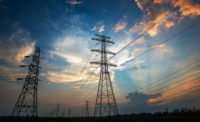Many protein producers see their operating assets head prematurely down the drain. By not taking adequate measures to cut water and energy use, which includes recirculating their resources and leveraging the optimal equipment and operating strategies, many plants are unnecessarily bolstering expenses while becoming more vulnerable to shortfalls in available supplies.
Operators that focus on conservation can win in the public relations arena by developing a reputation for being socially responsible, but the biggest impact will occur on their balance sheets, says Norman Marriott, emeritus professor in the College of Agriculture and Life Sciences at Virginia Polytechnic Institute and State University (Virginia Tech) in Blacksburg.
“The meat and poultry industry is a heavy consumer of water and it accounts for much of a plant’s labor and material costs,” he says. “Large operators can potentially save tens of thousands of dollars annually by focusing on conservation.”
Companies, meanwhile, have an abundance of options to save on water. The State of Maryland’s Water Supply Program, for instance, recommends plants replace high-volume hoses and wands with high-pressure, low-volume cleaning models; have conveying systems that handle waste materials in a dry state and contain easier to clean “rabbit ear” or V-shape roller supports; and establish the optimum depth of products on conveyors to maximize wash water efficiency.
In addition, operators can use solenoid valves to stop the flow of water when production stops, control belt sprays with a timer to allow for the intermittent application of chlorinated water and replace worn equipment with water-saving designs.
Managers also should ensure workers apply the proper amount of water when using chemical cleaners; discontinue the use of water to clean exterior areas such as sidewalks, driveways, loading docks and parking lots; and instruct employees to use hoses only when necessary, which includes having workers sweep and shovel solid materials from plant floors instead of moving objects with hoses.
Knowledge is power and savings
Indeed, Marriott notes a lot of water can be squandered in meat and poultry plants when workers use it to move debris toward a drain instead of picking up objects. Such rubbish frequently includes plastic film, small boxes and chunks of meat.
“It is done because the plant operators are not properly training sanitation employees,” he says. Plant workers also waste water when they use excessive amounts to wet equipment and facilities at the start of clean up, Marriott adds. He compares the initial application of water to hair washing, for which people just need enough dampness to get shampoo to lather.
“A major mistake is consuming too much water during the initial hose-down,” Marriott says. “Workers just have to apply enough so that everything is wet and then let the cleaning compound work.”
Similarly, he says, sanitation crews can use too much water when removing cleansers during wash downs, noting “it is a judgment call, but with proper training and supervision, workers will know when enough is enough.”
Judgment errors also occur if workers unnecessarily try to wash off sanitizers after they’ve been applied to the equipment and environment, Marriott notes.
“There is no need to rinse sanitizers if cleaning crews apply the proper concentration,” he says. Plants can further cut costs by reusing the water applied to clean in place (CIP) equipment and other areas of plants, he adds.
Once is not enough
Capturing excess water in holding tanks near drains, for instance, enables operators to reapply it for the initial wetting during the next cleaning cycle, Marriott notes. Before reusing the water, however, workers must first ensure it is clear of debris and microorganisms.
Treatment methods include trapping and removing matter with a mesh screen and skimming fat from the water surface. Marriott says operators can pump air into the water to force solid matter to rise more easily to the surface.
The cleaning equipment itself, meanwhile, also can be a key source of water savings. High-pressure, high-volume hoses, for instance, can expend 10 or more gallons of water per minute, while high-pressure, low-volume hoses might use just three gallons of water per minute, Marriott says.
The use of foam cleaners, which are prevalent in meat and poultry plants, can perhaps best streamline water use because adding the requisite air to mixtures decreases the water requirements, he says.
Further conservation options, are set to emerge as more organizations focus on solutions. Such parties include the Idaho Falls, Idaho-based Center for Advanced Energy Studies (CAES), a research and education consortium consisting of Boise State University, the Idaho National Laboratory, Idaho State University, the University of Idaho and the University of Wyoming, which is working to assist food processing companies in reducing their water and energy use.
“Processors face major issues with water and energy because it is a primary cost of their operations,” says Tom Wood, associate professor in the Department of Geological Sciences at the University of Idaho in Idaho Falls and CAES associate director. “Plant operators are looking to cut use while maintaining the same levels of service.”
Keeping a dry state wet
A key objective, Wood says, should be to efficiently reuse water in meat and poultry plants. Such measures are particularly valuable in regions where there is finite availability of surface and groundwater and, because of water rights laws, producers face limits in the amount of water they can obtain from its natural source.
“Some cities no longer allow operators to divert unlimited quantities of water to their plants,” Wood says. “Plant operators either have to try to buy water rights to increase the amount they can use or make better use of the water that they have in-house.”
Because not all water “needs to be of drinking standards,” he says there are major opportunities for processors to reuse water in operations, particularly in regions that are prone to shortfalls, such as the Mountain West.
“States like Idaho don’t have a huge amount of water, so it is important that meat and poultry operators look to recycle,” says Dennis Keiser, professor of engineering in the College of Engineering at the University of Idaho in Idaho Falls. “Many plants can’t get additional water from municipal facilities.”
Facilities that recirculate water should first treat it in the most efficient manner, he says, noting treatments to clear the water of substances can consume much of a worker’s time and energy and have a significant impact on a company’s bottom line. Treatments also might be necessary following reuse as some regulators require plants to discharge water in a relatively clean state, he says.
“Plants focusing on water conservation have to investigate how they can use a mix of technologies and methods to achieve better results while minimizing investments and overhead costs,” Wood says. “Technologies are evolving very quickly and operators need to keep up with what is occurring.”
Leveraging increasingly effective equipment and operating methods also will help operators respond to changing government regulations. Some plants, for instance, will face the regulatory burden of having to lower the contaminants in water to new levels before they can discharge the liquids from facilities, Wood says.
Get the edge on energy
Along with their water conservation systems, meat and poultry plant operators also can cut operating costs by focusing on energy reduction, he says. The CAES is studying ways plants can use new heating systems to slice production expenses, including the possible use of ultrasound and microwave technologies, Keiser says.
“The food processing industry is a huge consumer of electrical energy and natural gas and that has an effect on profitability,” he says. “It is important to look for alternate technologies that will provide cost benefits.”
Ultrasound technology, Keiser says, has the potential to more efficiently kill bacteria in meat and poultry and to extend product shelf life while cutting energy use.
“That is important as 50 to 60 percent of meat and poultry often ends up as waste because it goes beyond its shelf life,” he says. “Getting the shelf life expiration down to just 20 percent is a big accomplishment.”
Look to the future
While Keiser forecasts the widespread use of ultrasound and microwave technologies as heating alternatives is still about 10 years away, the impact could be powerful. He says with demand for meat and poultry likely to continue growing, processors looking to contain expenses must find ways to use the same amount of water and energy while increasing production. Among the available tools are technologies that pinpoint the weak links in operations where waste occurs, Wood says.
Yet, achieving optimal savings may require companies to invest heavily in retrofitting facilities to accommodate newer equipment, Keiser says, adding it will also demand retraining employees so they can best leverage the latest apparatus.
“The switching of technologies and techniques will be a major issue because of the need to alter and recapitalize plants,” he says. “Many processing facilities are aged and a significant part of structures will need to be redesigned and rebuilt to adapt to the newer systems.”
Meat and poultry operators, however, will likely recoup their investments in facility upgrades because of the subsequent operating efficiencies, Keiser says.
“That spending by operators in money and time on technologies and water and energy conservation efforts will be worth the effort because the eventual cost reductions will have a major impact on companies’ finances,” Wood says. NP





Report Abusive Comment